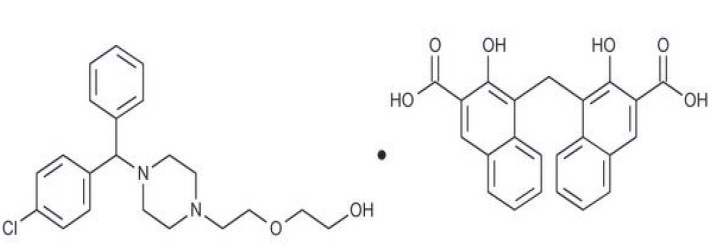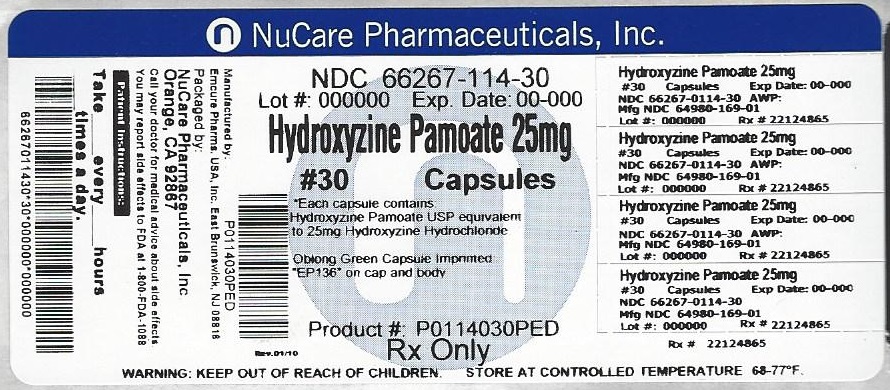HYDROXYZINE PAMOATE- hydroxyzine pamoate capsule
NuCare Pharmaceuticals, Inc.
----------
Rx only
DESCRIPTION
Hydroxyzine pamoate is a light yellow odorless powder, practically insoluble in water and methanol and freely soluble in dimethylformamide. It is chemically designated as (±)-2-[2-[4-( p-Chloro-α-phenylbenzyl)-1-piperazinyl]ethoxy] ethanol 4,4'-methylenebis[3-hydroxy-2-naphthoate] (1:1) and can be structurally represented as follows:

Chemical Formula: C
21H
27ClN
2O
2 . C
23H
16O
6
Molecular Weight: 763.29
Inert ingredients for the capsule formulations are: hard gelatin capsules (which contain gelatin, titanium dioxide, FD&C Blue #1, FD&C Red #40, D&C Yellow #10), printing ink which contains shellac glaze ~45% (20% esterified) in Ethanol, iron oxide black, n-butyl alcohol, isopropyl alcohol, propylene glycol and ammonium hydroxide 28%); magnesium stearate, microcrystalline cellulose, pregelatinized starch, sodium lauryl sulfate, sodium starch glycolate.
CLINICAL PHARMACOLOGY
Hydroxyzine pamoate is unrelated chemically to the phenothiazines, reserpine, meprobamate, or the benzodiazepines.
Hydroxyzine pamoate is not a cortical depressant, but its action may be due to a suppression of activity in certain key regions of the subcortical area of the central nervous system. Primary skeletal muscle relaxation has been demonstrated experimentally. Bronchodilator activity, and antihistaminic and analgesic effects have been demonstrated experimentally and confirmed clinically. An antiemetic effect, both by the apomorphine test and the veriloid test, has been demonstrated. Pharmacological and clinical studies indicate that hydroxyzine in therapeutic dosage does not increase gastric secretion or acidity and in most cases has mild antisecretory activity. Hydroxyzine is rapidly absorbed from the gastrointestinal tract and hydroxyzine pamoate's clinical effects are usually noted within 15 to 30 minutes after oral administration.
INDICATIONS
For symptomatic relief of anxiety and tension associated with psychoneurosis and as an adjunct in organic disease states in which anxiety is manifested.
Useful in the management of pruritus due to allergic conditions such as chronic urticaria and atopic and contact dermatoses, and in histamine-mediated pruritus.
As a sedative when used as premedication and following general anesthesia,
Hydroxyzine may potentiate meperidine (Demerol®) and barbiturates, so their use in pre-anesthetic adjunctive therapy should be modified on an individual basis. Atropine and other belladonna alkaloids are not affected by the drug. Hydroxyzine is not known to interfere with the action of digitalis in any way and it may be used concurrently with this agent.
The effectiveness of hydroxyzine as an antianxiety agent for long-term use, that is, more than 4 months, has not been assessed by systematic clinical studies. The physician should reassess periodically the usefulness of the drug for the individual patient.
CONTRAINDICATIONS
Hydroxyzine, when administered to the pregnant mouse, rat, and rabbit, induced fetal abnormalities in the rat and mouse at doses substantially above the human therapeutic range. Clinical data in human beings are inadequate to establish safety in early pregnancy. Until such data are available, hydroxyzine is contraindicated in early pregnancy.
Hydroxyzine pamoate is contraindicated for patients who have shown a previous hypersensitivity to any component of this medication.
WARNINGS
Nursing Mothers
It is not known whether this drug is excreted in human milk. Since many drugs are so excreted, hydroxyzine should not be given to nursing mothers.
PRECAUTIONS
THE POTENTIATING ACTION OF HYDROXYZINE MUST BE CONSIDERED WHEN THE DRUG IS USED IN CONJUNCTION WITH CENTRAL NERVOUS SYSTEM DEPRESSANTS SUCH AS NARCOTICS, NON-NARCOTIC ANALGESICS AND BARBITURATES. Therefore, when central nervous system depressants are administered concomitantly with hydroxyzine, their dosage should be reduced. Since drowsiness may occur with use of the drug, patients should be warned of this possibility and cautioned against driving a car or operating dangerous machinery while taking hydroxyzine pamoate. Patients should be advised against the simultaneous use of other CNS depressant drugs, and cautioned that the effect of alcohol may be increased.
Geriatric Use
A determination has not been made whether controlled clinical studies of hydroxyzine pamoate included sufficient numbers of subjects aged 65 and over to define a difference in response from younger subjects. Other reported clinical experience has not identified differences in responses between the elderly and younger patients. In general, dose selection for an elderly patient should be cautious, usually starting at the low end of the dosing range, reflecting the greater frequency of decreased hepatic, renal or cardiac function and of concomitant disease or other drug therapy.
The extent of renal excretion of hydroxyzine pamoate has not been determined. Because elderly patients are more likely to have decreased renal function, care should be taken in dose selections.
Sedating drugs may cause confusion and over sedation in the elderly; elderly patients generally should be started on low doses of hydroxyzine pamoate and observed closely.
ADVERSE REACTIONS
Side effects reported with the administration of hydroxyzine pamoate are usually mild and transitory in nature.
Skin and Appendages: Oral hydroxyzine hydrochloride is associated with fixed drug eruptions in post-marketing reports.
Anticholinergic: Dry mouth.
Central Nervous System: Drowsiness is usually transitory and may disappear in a few days of continued therapy or upon reduction of the dose. Involuntary motor activity, including rare instances of tremor and convulsions, has been reported, usually with doses considerably higher than those recommended. Clinically significant respiratory depression has not been reported at recommended doses.
In post-marketing experience, the following additional undesirable effects have been reported:
Body as a Whole: allergic reaction,
Nervous System: headache,
Psychiatric: hallucination,
Skin and Appendages: pruritus, rash, urticaria.
OVERDOSAGE
The most common manifestation of overdosage of hydroxyzine pamoate is hypersedation. Other reported signs and symptoms were convulsions, stupor, nausea and vomiting. As in the management of overdosage with any drug, it should be borne in mind that multiple agents may have been taken.
If vomiting has not occurred spontaneously, it should be induced. Immediate gastric lavage is also recommended. General supportive care, including frequent monitoring of the vital signs and close observation of the patient, is indicated. Hypotension, though unlikely, may be controlled with intravenous fluids and vasopressors (
do not use epinephrine as hydroxyzine counteracts its pressor action.) Caffeine and Sodium Benzoate Injection, USP, may be used to counteract central nervous system depressant effects.
There is no specific antidote. It is doubtful that hemodialysis would be of any value in the treatment of overdosage with hydroxyzine. However, if other agents such as barbiturates have been ingested concomitantly, hemodialysis may be indicated. There is no practical method to quantitate hydroxyzine in body fluids or tissue after its ingestion or administration.
DOSAGE
For symptomatic relief of anxiety and tension associated with psychoneurosis and as an adjunct in organic disease states in which anxiety is manifested: in adults, 50–100 mg q.i.d.; children under 6 years, 50 mg daily in divided doses; and over 6 years, 50–100 mg daily in divided doses.
For use in the management of pruritus due to allergic conditions such as chronic urticaria and atopic and contact dermatoses, and in histamine-mediated pruritus: in adults, 25 mg t.i.d. or q.i.d.; children under 6 years, 50 mg daily in divided doses; and over 6 years, 50–100 mg daily in divided doses.
As a sedative when used as a premedication and following general anesthesia: 50–100 mg in adults, and 0.6 mg/kg in children.
When treatment is initiated by the intramuscular route of administration, subsequent doses may be administered orally.
As with all medications, the dosage should be adjusted according to the patient's response to therapy.
HOW SUPPLIED
Hydroxyzine Pamoate Capsules (hydroxyzine pamoate equivalent to hydroxyzine hydrochloride)are available as:
25 mg capsules: two-tone green capsules, cap and body imprinted EP136 in black ink. They are supplied as follows:
Bottles of 20: NDC 66267-114-20
Bottles of 30: NDC 66267-114-30
Bottles of 60: NDC 66267-114-60
Store at 20°-25°C (68°-77°F) [see USP Controlled Room Temperature].
Dispense in tight, light resistant containers (USP).
Manufactured for:
Rising Pharmaceuticals, Inc.
Allendale, NJ 07401
MF# 0334-04
Revised: 07/2014
Principal display panel-25mg label
HydrOXYzine Pamoate Capsules USP 25 mg
Rx only
Each capsule contains hydrOXYzine pamoate USP equivalent to 25 mg hydroxyzine hydrochloride.
USUAL DOSAGE
Adults : 25 mg t.i.d. to 100 mg q.i.d.
Children : Under 6 years - 50 mg daily in divided doses.
Over 6 years - 50 to 100 mg daily in divided doses. See accompanying prescribing information.
Store at 20°-25°C (68°-77°F) [see USP Controlled Room Temperature].
Dispense in tight, light resistant containers (USP).
TARTRAZINE DYE FREE.
Manufactured for:
Rising Pharmaceuticals, Inc.
Allendale, NJ 07401
| HYDROXYZINE PAMOATE
hydroxyzine pamoate capsule |
|||||||||||||||||||||||||
|
|||||||||||||||||||||||||
|
|||||||||||||||||||||||||
|
|||||||||||||||||||||||||
|
|||||||||||||||||||||||||
|
|||||||||||||||||||||||||
|
|||||||||||||||||||||||||
| Labeler - NuCare Pharmaceuticals, Inc. (010632300) |
| Establishment | |||
| Name | Address | ID/FEI | Business Operations |
|---|---|---|---|
| NuCare Pharmaceuticals, Inc. | 010632300 | repack(66267-114) | |
